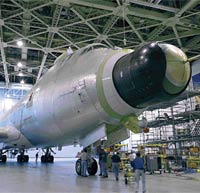Boeing's airborne laser (ABL) aircraft, which will house the revolutionary ABL ballistic missile defence system, made its maiden flight last Thursday from the company's Wichita, Kansas plant.

The aircraft, sporting a distinctive nose turret and top-mounted laser-targeting pod, flew a 90min flight plan as part of its summer-long flight-worthiness test schedule.
The ABL will have its sophisticated tracking and high-energy laser system installed later this year – the laser has so far only been fired on the ground
The complex laser generation and fire control systems will fill the Boeing 747-400 while the Lockheed Martin-built beam control and primary mirror have proved to be equally complex and cumbersome.
A Bloomberg report last week, quoting the General Accounting Office, said the aircraft and system may be redesigned because the weapon exceeds weight requirements. The laser was designed to weigh less than 175,000lb (79,000kg), but the new GAO report says US Air Force engineers have determined the first will weigh 180,000lb.
The ABL will soon be joined by a smaller advanced tactical laser (ATL) project, with the potential to be mounted on the Lockheed Martin C-130.
The ATL project is being considered by the US special operation command and uses a similar chemical oxygen iodine (COI) laser to its big brother. The difference is that power levels will be down by a factor of 10, resulting in a shorter range.
Boeing's Donald Shoffstall explains that the ATL will be able to hit targets without causing collateral damage.
"You will have to figure out what these might be, but they might include immobilising vehicles or causing lethal damage in a very small area," he says.
"The airborne laser is really the ‘silver bullet' for defence and we still need to find out just what it can do," says Shoffstall
Source: Flight Daily News























